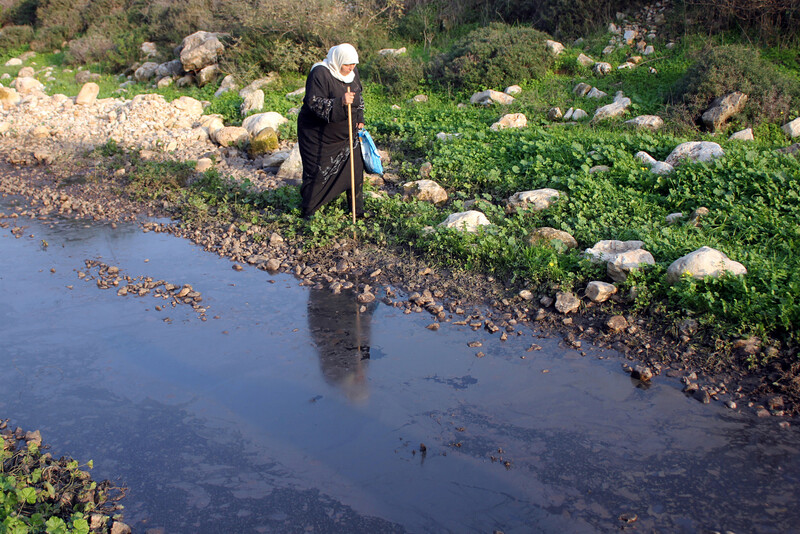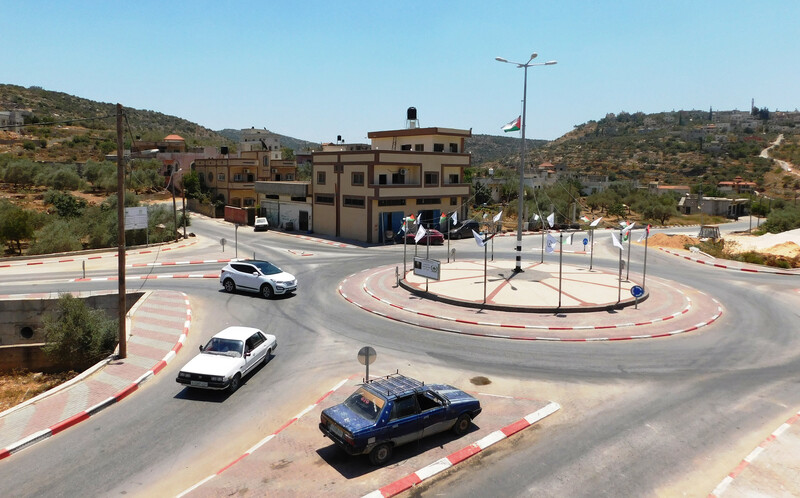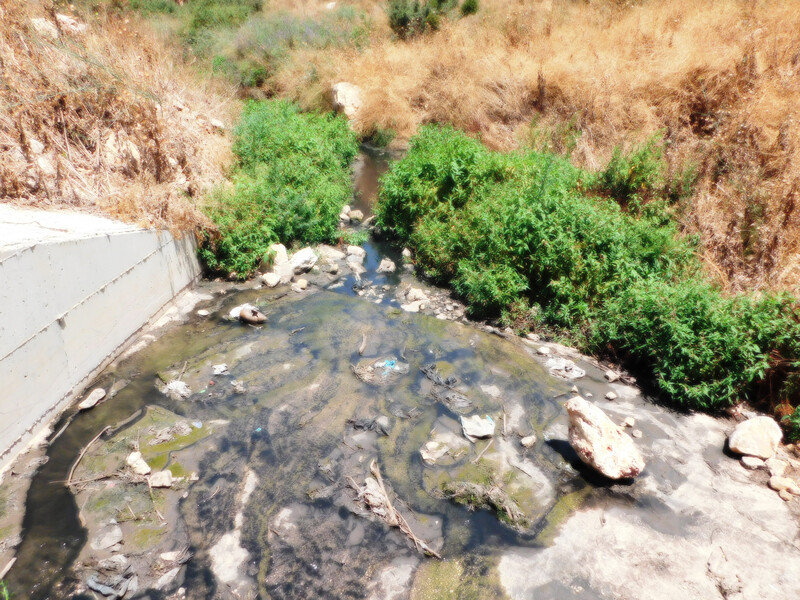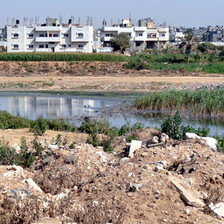The Electronic Intifada 31 August 2016

A Palestinian woman walks next to sewage water flowing from Israeli settlements in the West Bank village of Kafr Thulth, near Qalqilya, December 2012.
ActiveStillsAbu Mazen Square has become a bit of a joke for Palestinian residents in the occupied West Bank town of Bruqin.
To understand why, it is imperative to delve into recent history.
Two years ago, the site of what is now a public square was an open cesspool. Wastewater pumped out of the nearby Israeli settlement Ariel, one of the largest in the West Bank. This wastewater mingled with overflow from nearby Salfit.
Salfit, a town of some 9,000 Palestinians, has spent the past 22 years trying to update its sewage management system, according to chief municipal engineer Saleh Afaneh, but has not been able to get the necessary permits from the Israeli military authorities. Consequently, wastewater has been flowing down freely, joining the natural stream that runs through Bruqin village.
The Salfit government has little power to reduce the amount of sewage entering Bruqin and the neighboring Palestinian village Kufr al-Dik, but it has supplied a few kilometers of pipeline to keep the mess underground in the most densely populated parts of the two towns.
While only four out of 15 planned kilometers of pipeline have been built so far, the Palestinian Authority took the opportunity to build a lavishly decorated new town square, dedicated to Mahmoud Abbas, the PA president, directly over the line, giving Bruqin’s local residents Abu Mazen Square. A kilometer away, the sewage continues to flow openly.
The story of Abu Mazen Square is an execrable reminder for many in Bruqin that their problems are being glossed over by the Palestinian Authority. While sewage leaks have plagued the village for years, the PA and its Ministry of Health have offered a minimal amount of relief, and have abandoned attempts to advocate for rural communities suffering from wastewater mismanagement.
The PA might claim that all is well, but beneath the surface the situation stinks.
Sewer politics
Wastewater management is a problem in the West Bank.
Approximately half of Israel’s environmental regulations do not apply in the occupied territory. With such lax legislation, companies producing metals, chemicals and plastics flock to settlement industrial zones, such as West Ariel and Barkan. Both Israeli and international companies are drawn to areas where they can pollute more freely, often at the expense of surrounding Palestinian communities.
The Oslo accords signed by Israel and the Palestine Liberation Organization in the mid-1990s saw the West Bank carved up into areas A, B and C with the Palestinian Authority exercising a diminishing level of control over the internal affairs of Palestinian communities in those areas.
For project approval in Area C — the some 60 percent of the West Bank under full Israeli civilian and military control — Palestinian towns and villages must apply to the Israeli body which oversees civilian affairs in occupied territory.
It is the Israeli military that ultimately decides whether Palestinians can build new sewage infrastructure and wastewater treatment plants in places like Salfit where, according to Afaneh, there is no available land in areas A and B, where the Palestinian Authority exercises civilian control, for such projects.

For many residents in Bruqin village, Abu Mazen Square represents the Palestinian Authority’s misplaced priorities.
But the Israeli authorities refuse the vast majority of applications. Making matters worse, since the beginning of 2016, the Israeli military has demolished more than 50 water and sanitation structures in Area C.
The lack of adequate sewage treatment poses a serious risk to public health. During the winter rains, wastewater overflows its containment pipes, creating a higher risk of contaminating groundwater.
In the summer, when the West Bank faces massive water cuts imposed by Mekorot, Israel’s national water company, Palestinians are forced to turn to polluted water sources to meet needs.
Farmers and herders in the area also report that free-flowing sewage damages crops and can poison animals, undermining livelihoods and negatively affecting the quality of food available in rural communities.
Crisis? What crisis?
One wouldn’t know any of this, however, from talking to Palestinian Authority officials.
Haytham Mansour is director of the Ministry of Health in the Salfit region. Mansour refused to be drawn out on whether there is a water crisis in the area. While he acknowledged both water cuts and sewage leaks, he was adamant that both were under control and did not cause undue suffering in the Salfit region.
He insisted that his department tests local water on a weekly or monthly basis. Yet he would not share the findings of those reports or even confirm that the ministry kept records on water quality.
Mansour did concede that the overflow of sewage, combined with the lack of access to potable water, could hypothetically put communities at risk from anything from scabies to Hepatitis A, but maintained that the Salfit region had not seen any significant increase in those maladies.
But his denials, and those of his deputies, seem to fly in the face of evidence collected independently.
Mohammad Bishr, a doctor with the Palestinian Medical Relief Society’s Salfit branch, is concerned. As a participant in a mobile clinic program, he regularly visits both Kufr al-Dik and Bruqin to offer free consultation and primary health care services to underserved communities.
In an interview with The Electronic Intifada, Bishr said that since the beginning of June, the nongovernmental organization has noted an increase in the number of patients with scabies, gastroenteritis and gastrointestinal amebiasis, a miniature epidemic that repeats itself every summer. He attributed this pattern to a lack of proper sanitation and the domestic use of polluted drinking water.
Bishr also noted that patients were concerned over the size and frequency of mosquito bites they sustained in recent years. Small pools of sewage provide optimal breeding grounds for mosquitoes.
“We’ve started to see this every time the water goes [out],” noted Bishr. “Every summer, it gets worse.”
Bassam Madi, another doctor with the Palestinian Medical Relief Society mobile clinic program, worries that if the sewage crisis is not adequately addressed, there will be further increases in communicable diseases.
Crucial evidence
But to address a problem, it first needs to be acknowledged.
With no access to water quality reports from the Ministry of Health, local clinicians and public health officials are at a disadvantage. The Palestinian Medical Relief Society and local government officials have access to just a single independent report, obtained after an Israeli activist sent samples of water from polluted streams outside the Ariel settlement and the Barkan Industrial Zone to Aminolab in Israel.
Some samples showed high levels of organic waste, consistent with untreated industrial waste. Others showed waste consistent with unrestricted dumping. Additional samples showed evidence of intermittent filtration.
Aminolab noted in its report, seen by The Electronic Intifada, that this level of contamination in certain areas deviates from the Inbar standards, the Israeli regulations on water quality. While the report is not comprehensive, it includes enough detail to confirm that industrial pollutants from settlements are entering water used for agricultural and household purposes by thousands of Palestinians in the Salfit district.

A polluted stream on the outskirts of Bruqin.
The mayors of Bruqin and Kufr al-Dik have been equally dependent on the lone water quality report from Aminolab and confirmed to The Electronic Intifada that the Palestinian Authority Ministry of Health had taken almost no measures to address the wastewater problem in their towns.
Jamal al-Dik, the mayor of Kufr al-Dik, said that in 30 months of construction, the PA had only completed a little more than a quarter of the planned 15 kilometers of the sewage diversion pipeline that gave rise to Abu Mazen Square. Currently, this pipeline is only keeping sewage at bay in the most heavily populated areas.
The mayor did say that the ministry this year had supplied Kufr al-Dik with a small shipment of mosquito spray, though not enough to supply every household. The health ministry, he said, had been ignoring the escalating public health threat for years.
“This is an old story, but also our future,” the mayor added.
After years of trying to hold a public health crisis at bay with minimal assistance from the ministry, local residents and health workers are losing confidence in finding a solution to the sewage crisis, and losing confidence in their government.
Politics of water
The politicization of water in the West Bank is nothing new.
Under the Oslo accords, a Joint Water Committee, with equal numbers of Palestinians and Israelis, was established to oversee water and sanitation issues in the occupied West Bank and Gaza Strip. While representation within the committee was hypothetically equal, Israel’s military control over Area C gave Israel effective veto power over the committee’s decisions. As a result, almost no Palestinian proposals to the joint committee ever came to fruition.
In 2010, Palestinian Authority representatives stopped giving their approval to Israeli proposals at the joint committee in protest. The Palestinian delegation failed, however, to combine their protest with any strategy to mitigate the effects of stressed water infrastructure for the Palestinian population.
The Israeli military occupation puts a burden on the Palestinian Authority’s health ministry as well. The World Health Organization estimates that in 2015 the ministry was unable to procure an estimated 30 percent of essential medicines, and 25 to 30 percent of medical equipment and laboratory supplies, due to budget shortfalls as well as Israeli restrictions on movement, which limit the flow of medical goods and personnel.
In addition to restricting access to medical supplies, the violence of the military occupation mean hospital beds are filled with those who have been injured by Israeli soldiers and settlers. The restricted access to potable water simply adds more pressure on already overstressed Palestinian public health institutions.
The Ministry of Health could face political consequences for protesting the causes of the sewage crisis. The ministry’s budget for 2015 was some $323 million, according to the World Health Organization. During the same year, the US government agency USAID donated $7.6 million to the Palestinian Authority for basic health projects and $45 million for water and sanitation.
The health ministry remains caught between acknowledging the overtly political causes of a public health crisis, and the political risk of taking concrete action against the occupation.The US government has previously set a precedent in using aid as a bargaining chip against the PA as possible punishment for state-building activities.
The Palestinian Medical Relief Society’s Bassam Madi believes that the problem of a lack of access to potable water will be solved when the PA, and its donors, are ready to address the matter as a public health crisis, not as a political issue.
“Let’s address the human issue, let’s address the environmental issue,” he said during a break from his work with the mobile clinic.
But, if Abu Mazen Square is any indication, the PA seems more interested in keeping up political appearances, whatever the underlying reality. The needs of vulnerable villagers in the Salfit district do not compete with this priority.
At present, the Palestinian Authority is addressing neither the “human issue” described by Madi nor the underlying political reality of Israeli control and abuse of the environment.
Clare Maxwell is a journalist and human rights activist working in the Salfit region of the West Bank.



